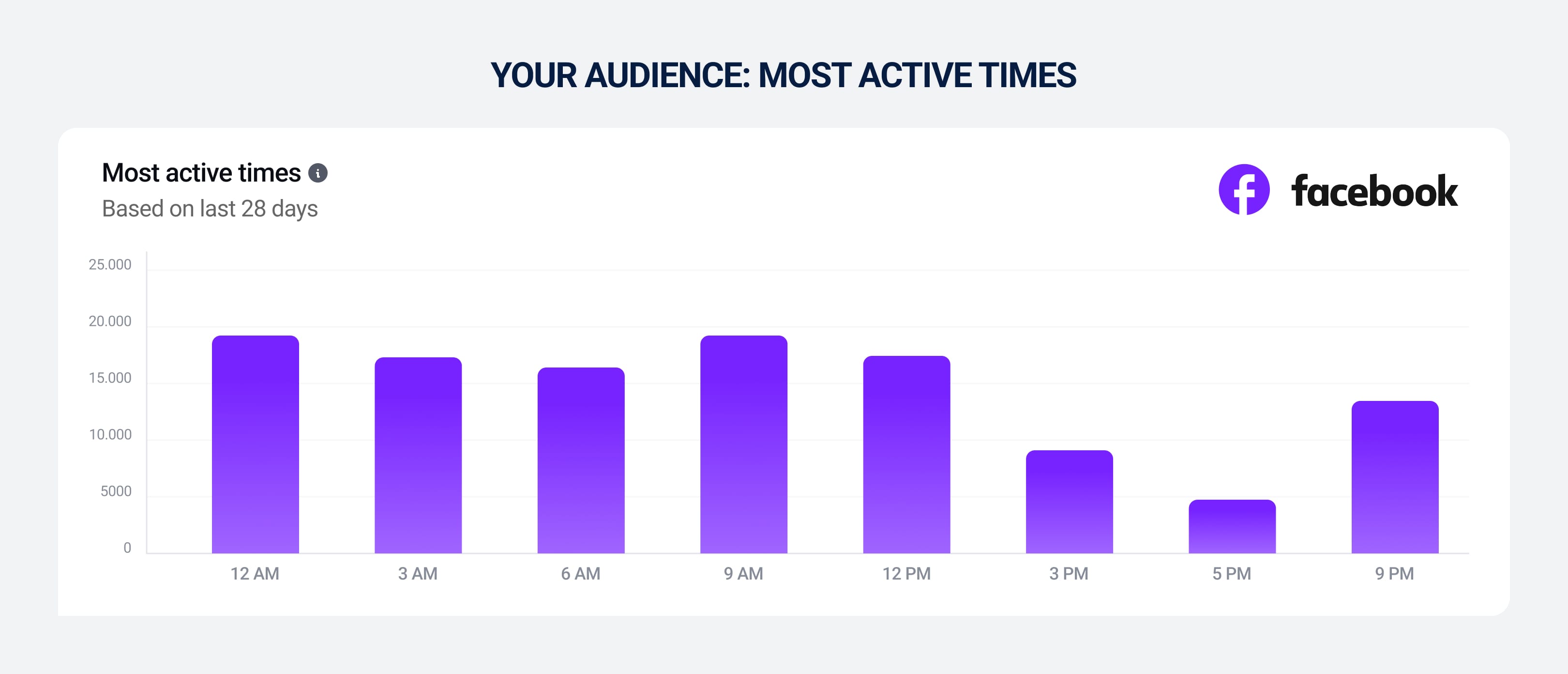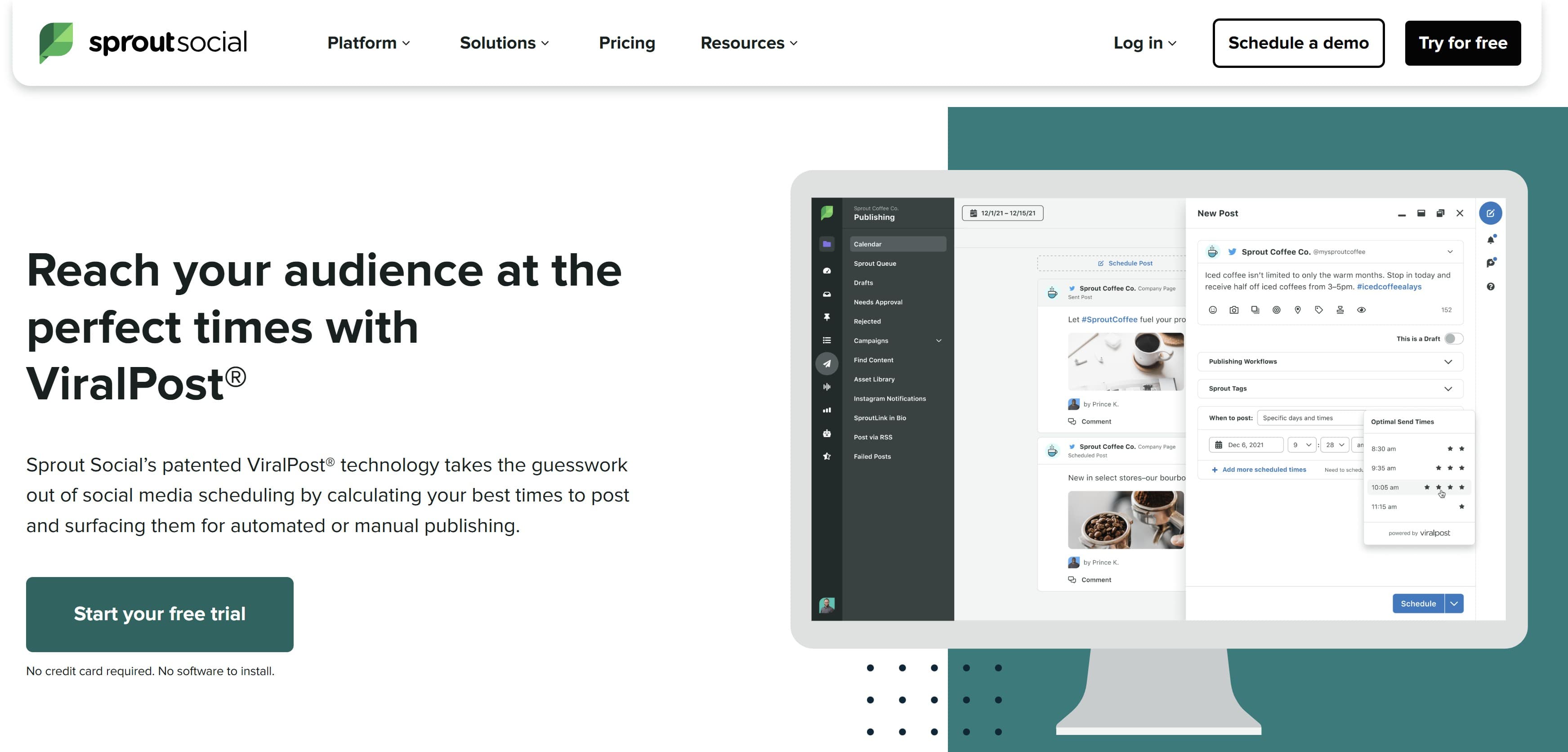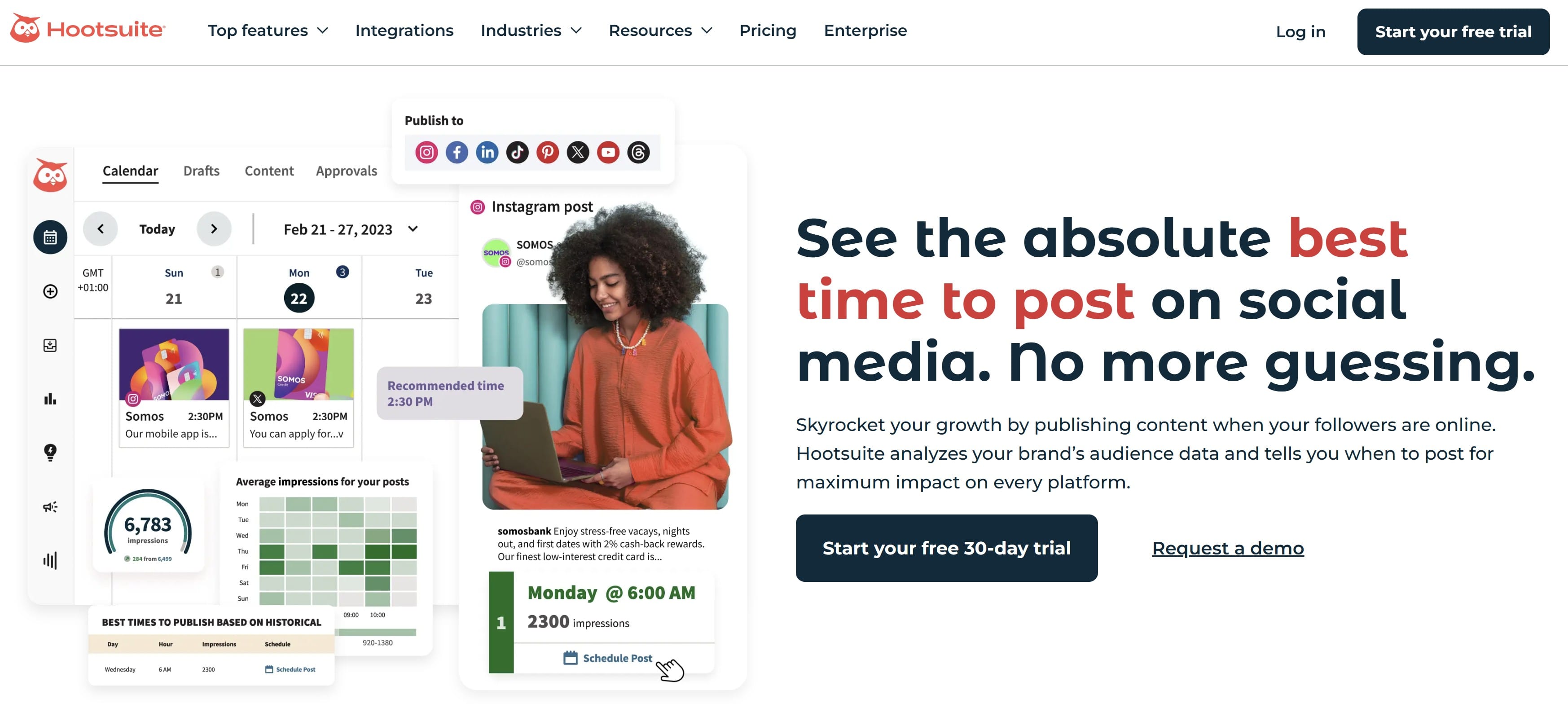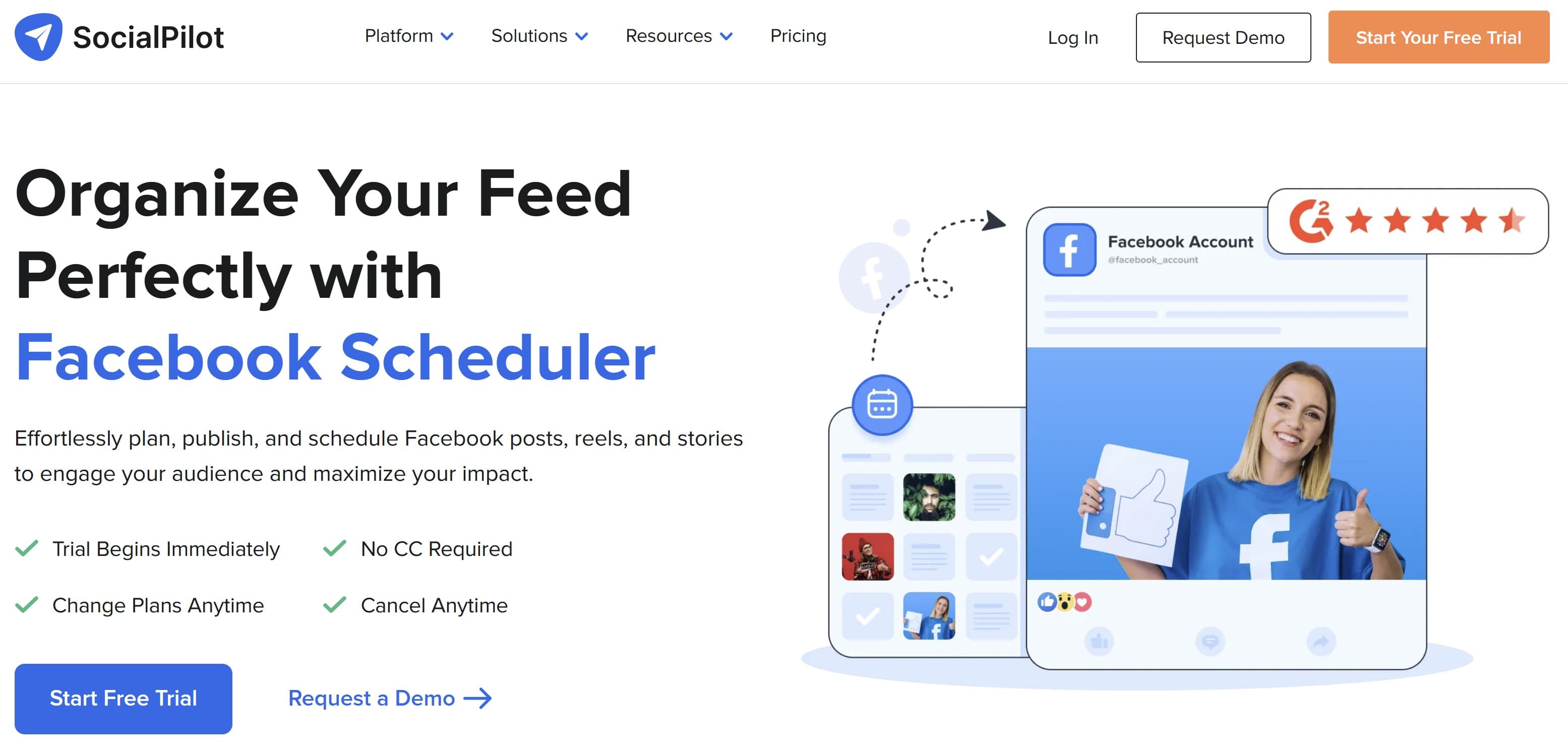If you’re posting on Facebook without thinking about timing, you’re leaving tons of engagement on the table. Whether you’re managing a brand page, running ads, or growing a community, when you post matters just as much as what you post.
The Facebook algorithm favors recency, meaning newer posts are more likely to appear in users’ feeds. That gives you a small but critical window to get noticed.
In this guide, you’ll learn exactly when to post on Facebook for maximum visibility and engagement, backed by global data, industry trends, and platform-specific insights.
- Quick overview: best times to post on Facebook (based on global data)
- Best time to post on Facebook by day of the week
- Best time to post on Facebook by industry
- Best time to post on Facebook by audience demographics
- Best time to post on Facebook by location
- Does the time zone affect Facebook post engagement?
- How to find your best time to post on Facebook
- Best tools to discover the best time to post
- Best posting time for different Facebook formats
- Conclusion
Quick overview: best times to post on Facebook (based on global data)
In 2024-25, Sprout Social analyzed 2.5 billion engagements across more than 600,000 social profiles. According to them, the times to post on Facebook for maximum engagement are generally during weekday mornings, between 8:00 AM and 12:00 PM local time.
Here's a more in-depth breakdown:
| Day | Optimal posting times (local time) |
|---|---|
| Monday | 9:00 AM – 12:00 PM |
| Tuesday | 8:00 AM – 12:00 PM |
| Wednesday | 8:00 AM – 11:00 AM, 3:00 PM |
| Thursday | 8:00 AM – 12:00 PM |
| Friday | 9:00 AM – 10:00 AM |
| Saturday | 9:00 AM |
| Sunday | 8:00 AM – 12:00 PM |
Additional research indicates that early morning posts, especially between 5:00 AM and 7:00 AM on weekdays, can also yield high engagement. The largest demographic of Facebook users is 25-34 years old, followed by the 35-44 demographic. Both of these groups get up to start their day within this time frame before heading to work sometime around 8:00 or 9:00.
And, of course, most of them are going to check Facebook before getting up.
Best time to post on Facebook by day of the week
Based on 2025 research from more than 3.5 million Facebook posts across multiple sources, these are the best times to post on Facebook by day of the week:
| Day | Optimal posting times (global) | Notes |
|---|---|---|
| Monday | 9:00 AM – 12:00 PM | Strong engagement early in the week. |
| Tuesday | 9:00 AM – 12:00 PM | Peak engagement day; 9 AM is especially effective. |
| Wednesday | 8:00 AM – 11:00 AM, 3:00 PM | Consistent midweek engagement; multiple active periods. |
| Thursday | 8:00 AM – 12:00 PM | Similar patterns to Tuesday; consider A/B testing. |
| Friday | 9:00 AM – 10:00 AM | Engagement tapers off as the weekend approaches. |
| Saturday | 9:00 AM | Lower overall engagement; early posts perform better. |
| Sunday | 8:00 AM – 1:00 PM | Least engagement; morning posts fare relatively better. |
Tuesday is the clear winner. It consistently shows the highest engagement across studies. Users are active, alert, and back in their weekly rhythm. Wednesday also performs well because midweek posts get strong traction as people scroll during lunch or afternoon slumps.
On the flip side, Saturday and Sunday are the weakest days for engagement. Most users are offline or on other platforms. Unless you're in entertainment or hospitality, skip the weekends.
Worst times to post? Between 8 PM and 5 AM. Late-night and early-morning posts usually get buried before the majority of your audience is active.
The takeaway: Stick to weekdays, aim for mid-morning to early afternoon, and don't waste a good post by sending it late at night.
Best time to post on Facebook by industry
Different industries see different patterns. What works for a fitness brand won’t always work for a SaaS company (though there is plenty of overlap). While the overall best times to make Facebook posts tend to be earlier in the day, we also find that
We've compiled data from multiple sources below:
| Industry | Optimal posting times |
|---|---|
| Media and entertainment | Early mornings on Thursdays and Saturdays |
| Education | Mon 1–3 PM, Tue 5 PM, Thu 11 AM–1 PM |
| Healthcare | Saturday 11 AM–1 PM |
| Government | Saturday 9 AM–6 PM, Sunday 9 AM–12 PM |
| Retail and consumer goods | Wed–Sat 8–10 AM, Tue & Thu 5–6 PM |
| Food, beverage, and hospitality | 9 AM–12 PM |
| Financial services | Tue 4–6 PM, Wed 3 PM, Thu 9 AM–12 PM |
| Technology | Wed 12 PM, Thu 11 AM–5 PM |
In tech and financial services, late afternoons and mid-mornings tend to perform best. These windows align with breaks between meetings or those mid-shift scroll sessions when professionals are most likely to check social.
Meanwhile, healthcare and government content generally performs better on weekends. These sectors are intense during the week, so downtime scrolling typically happens Saturday and Sunday.
As for education audiences, their engagement is almost exactly aligned with school start, lunch, and end times. Teachers don't get a break during classtime, but they do get 30 minutes to check Facebook before and after.
In food, beverage, and hospitality, keep in mind that most restaurants, bars, clubs, hotels, and event centers are more active during afternoons and nights, because that's when all the other people are off work and able to attend. This serves to explain why they get a later start to their morning, but are still far more active during that late morning.
Best time to post on Facebook by audience demographics
There’s no public data that breaks down Facebook engagement by age, gender, or occupation (at least not in a way that gives exact posting times). But that doesn’t mean you should ignore demographics. In fact, your audience profile can give you a head start on your posting strategy.
Occupation is the most reliable timing signal.
A 9-to-5 employee is reachable mid-morning, lunchtime, and around 3–4 PM (as are most entrepreneurs). Meanwhile, healthcare workers, restaurant staff, and gig economy professionals often operate outside traditional hours.
Gender-based behavior isn’t about preference.
It’s about daily rhythm. If your audience is mostly women balancing work and caregiving, mid-morning and mid-afternoon are strong windows, especially after school drop-offs or during a break in routine.
Age is more ambiguous.
Most adults wake up between 6:00 and 7:30 AM, driven by work or school routines. But, then again, so do kids for the same reasons. That means, across the board, your post is more likely to get seen if it’s live by the time they check their phone.
Best time to post on Facebook by location
| Time zone | Best times to post on Facebook |
|---|---|
| Arabia Standard Time (AST) | 3 PM on Tuesdays, 2 PM on Thursdays, 4 PM on Fridays |
| Japan Standard Time (JST) | 2 PM to 4 PM on Wednesdays |
| Atlantic Standard Time (AST) | Between 10 AM and 9 PM |
| Eastern Standard Time (EST) | 7 PM to 9 PM on Mondays and Wednesdays |
| Central Standard Time (CST) | 7 PM on Wednesdays |
| Central European Time (CET) | 10 AM – 1 PM on Tuesdays; 6 AM – 9 AM on Wednesdays; 5 AM – 7 AM on Thursdays & Saturdays; 11 AM on Sundays |
| Mountain Standard Time (MST) | 5 PM from Monday to Wednesday |
| Pacific Standard Time (PST) | 5 PM on Mondays and Wednesdays |
| Newfoundland Time (NT) | Midday Monday to Saturday; 9 PM on Tuesdays and Thursdays |
| India Standard Time (IST) | 7–9 AM and 6–9 PM on weekdays |
| Coordinated Universal Time (UTC) | 1 PM to 7 PM on Sundays |
Location plays a subtle but important role in post timing. While the Facebook algorithm operates globally, user behavior still follows local routines. Work hours, meal times, and cultural habits all shape when people are most active.
In Europe, earlier mornings (7-9 AM) and late evenings (7-9 PM) tend to perform best. Users often check their phones before work or after dinner, making those prime slots for visibility.
In the United States, late mornings to early afternoons (10 AM-1 PM) are strong, as well as post-work hours after 5 PM when people are unwinding and catching up on social.
For audiences in the Middle East, mid-to-late afternoon tends to see higher engagement, often between 2-4 PM.
GROW YOUR INSTAGRAM FOLLOWING VIA OUR CELEBRITY CAMPAIGNS
Leverage the power of the worlds A-list celebrities to grow your Instagram every month
VIEW CAMPAIGNSDoes the time zone affect Facebook post engagement?
Yes, time zone absolutely matters. Facebook prioritizes recency, so your post needs to go live when your audience is online, not when you are.
If you’re in Dubai but your audience is in Los Angeles, there’s an 11-hour gap (or 12, depending on the time of year). A post that goes live at 9 AM your time will hit their feed at 10 PM — long after peak engagement hours.
This is a common mistake for global teams and digital nomads. You should always schedule posts based on your audience’s local time, not your own.
How to find your best time to post on Facebook
All the benchmarks in the world won’t beat data from your own audience. While general trends are a great starting point, the real insight comes from watching when your followers engage.
So, how do you figure that out?
Strategy #1: Use Meta Business Suite.
If you’re managing a Facebook Page, Meta Business Suite gives you direct access to your audience activity data.
Here’s how:
- Go to Meta Business Suite and open your Page.
- Click Insights in the left-hand menu.
- Under Audience, you’ll see demographic details like age, location, and gender.
- From there, navigate to Trends, where you'll find information on your Facebook followers' most active times.

Once you’re done, check the Content tab to see when your audience is most active and which posts performed best over the last 28 days.
Look for patterns in time of day and post type. Are your videos doing better at night? Do carousels get more clicks at lunch?
Once you spot what’s working, schedule more posts in that window. You’ll likely see a noticeable lift in engagement.
Strategy #2: Use a third-party Facebook tool.
If you want deeper analytics or you manage multiple accounts, third-party tools give you more precision than Meta’s native tools.
Platforms like Sprout Social, Hootsuite, Buffer, and Later analyze your past performance to recommend the best times to post. And they're based on actual engagement data from your page. They also show audience activity by the hour, post type breakdowns, and trends over time.
These tools are particularly useful if:
- You’re posting across multiple time zones
- You want to compare best times across different platforms
- You need more visual, digestible data than Meta offers
Most of them include scheduling features too, so you can queue content to hit at the exact right time, even if it’s 2 AM your time.
Best tools to discover the best time to post
You've got plenty to choose from when it comes to Facebook analytics tools. And these platforms can help you manage your other social media profiles as well, so they give you the added benefit of centralization.
Without further ado, let's dive in.
Sprout Social
Sprout Social's ViralPost® is a patented feature designed to optimize the timing of your social media posts for maximum audience engagement. It analyzes your audience’s engagement patterns, content velocity, and several other metrics. Then, it calculates your best times to post and surfaces them for automated or manual publishing.

Its scheduling feature also allows you to A/B test post times on your own, giving you conclusive results on what’s the most effective time for each type of content.
The platform itself stands out as an all-in-one social media management platform. Generative AI-powered copywriting, centralization for multiple profiles, networks, and campaign tags, social listening tools, and employee advocacy features are all within its wheelhouse.
Best for: Data-driven scheduling and analytics.
Hootsuite
Hootsuite's Best Time to Publish feature analyzes your social media performance data from the past 30 days to recommend the most effective times to post. From that, it gives you personalized suggestions based on your audience's online activity and engagement trends.

There are two ways to access it:
- Hootsuite Analytics: Navigate to the "Best time to publish" section under Organic reporting to view heatmaps indicating when your audience is most active.
- Hootsuite Composer: While drafting a post, click Schedule Post, and Hootsuite will suggest optimal posting times based on your audience data.
Like Sprout Social, Hootsuite offers multi-platform support, in-depth analytics, and comprehensive tools for content planning.
Best for: Large teams and agencies.
SocialPilot
With SocialPilot's Facebook scheduler, all you have to do is connect your Facebook page, then define your ideal time slots. You can pick one or several days and set their posting times in advance. Once you add a post to the queue, it’ll automatically be scheduled to go out during your chosen time slots.

This handy feature also lets you do A/B testing by posting the same content on different days. By doing this over time, you'll figure out the best times to share specific types of content.
Best for: Individuals, small to mid-sized social media teams, and agencies.
Best posting time for different Facebook formats
There’s no public data yet breaking down the best time to post for each Facebook format. But each one behaves differently in the algorithm, and timing still plays a role in how they're seen and shared.
Reels
Reels are pushed heavily by the Facebook algorithm, both for users who already follow you and those who don't. You have to give the algorithm enough time to gather signals and start distributing.
This is why we recommend posting early in the day. The algorithm needs time to test and circulate your content. Posting in the morning gives your Reel the full day to build momentum.
Stories
Facebook Stories aren't chronological. Instead, the algorithm ranks them based on how likely a user is to care about them, using past interactions, profile activity, and engagement history as signals.
When you post 3-5 times a day, each new Story gives you more opportunities to drive engagement from your audience. Spread them out, though. Instead of dumping five Stories at once, space them out across morning, midday, and evening to extend your visibility.
Carousels
Carousels are built for depth. The algorithm rewards you by giving your post more visibility after it sees early interaction (i.e., swipe-through behavior).
To optimize it, post when your audience is most focused. Late night, early morning, or mid-commute hours will more likely lead to swipe fatigue or quick exits. And remember to hook with the first slide, because strong openers lead to better dwell time, which gives the algorithm what it’s looking for.
Lives
Unlike other formats, Lives depend on real-time presence. You need to go live when your audience is actually online and ready to engage.
According to data from CommentSold, the best day to go live is Wednesday, especially between 11 AM and 1 PM. That midweek, late-morning window consistently drives strong traffic and interaction. More broadly, going live between 9 AM and 3 PM on weekdays tends to perform well, likely because people are in work mode but still checking in during breaks.
But avoid Sundays and any time before 7 AM or after 5 PM. Engagement drops off hard during these hours, either because people are offline or shifting focus to other platforms and activities.
Note: Your own follower data still trumps averages here. Find your best time to go live based on when your following is most active.
Conclusion
While we've talked a lot about averages, the best time for you to post on Facebook is more of a moving target based on your audience, industry, location, and format than it is a fixed rule. While global data gives you a strong starting point, the real power comes from tailoring your timing to when your followers are most active and engaged.
Start with Meta Business Suite, but eventually graduate to a third-party platform you can use to test, measure, and refine your posting strategy.
And if you need help building a strategy that’s customized to your business, including post timing, content format, and full-funnel campaigns, we can do that for you.

